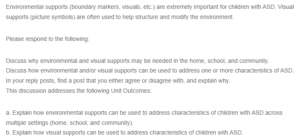The Importance of Environmental and Visual Supports for Children with ASD
The learning environment is critical for children with Autism Spectrum Disorder (ASD). Environmental and visual supports can help these children succeed in their home, school, and community settings. At home, environmental and visual supports can help children with ASD establish routine and predictability, decrease distractions, provide structure for daily activities, and create a calmer atmosphere (Machado & Botnarescue, 2010). For instance, when a visual schedule is displayed, a child with ASD can become more aware of the order and sequence of tasks in their day. In the school setting, environmental supports such as designated seating areas for breaks, cues for transitions, and clutter-free workspaces can help reduce distractions, provide structure, and support independence. Additionally, classroom visuals like picture symbols or words can assist with understanding tasks and instructions and reinforce concepts. Visual supports like maps and schedules can help understand activities, locations, and time in the community setting. For instance, as they attend recreational activities, children with ASD can use visual supports to track their activity progress. Sporting events, such as baseball, can be supported with visuals like picture cards to remind the child of the rules.
Visual supports, including picture symbols, words, and objects, can help children with ASD understand abstract concepts or ideas. When encouraging a reading or writing culture, visuals can strengthen the learning of words. Picture symbols can also support communication when verbal language is limited or absent by providing an alternative form of expression (Machado & Botnarescue, 2010). Boundary markers, for example, can create a contained space for the child to focus on an activity. Environmental supports like organizational systems can help children with ASD process information easily and identify their belongings. For instance, coloured labels or bin organizers can teach order and systematization. In addition, in pronouncing words with multiple syllables, visuals can be used to help the child break down words into individual parts (Larcombe et al., 2019). In addition, visuals can teach concepts like social skills, personal hygiene, and appropriate behaviour.
Conclusion
As learners, children with ASD can benefit greatly from environmental and visual support. These supports can help create an environment that best meets the child’s needs and provides structure, predictability, and understanding. Environmentally- and visually-supportive strategies can be used in various settings to help children with ASD reach their potential.
References
Larcombe, T. J., Joosten, A. V., Cordier, R., & Vaz, S. (2019). Preparing children with autism for transition to mainstream school and perspectives on supporting positive school experiences. Journal of Autism and Developmental Disorders, 49(8), 3073-3088.
Machado, J. M., & Botnarescue, H. M. (2010). Student teaching: Early childhood practicum guide. Cengage Learning.
ORDER A PLAGIARISM-FREE PAPER HERE
We’ll write everything from scratch
Question
Environmental supports (boundary markers, visuals, etc.) are extremely important for children with ASD. Visual supports (picture symbols) are often used to help structure and modify the environment.

The Importance of Environmental and Visual Supports for Children with ASD
Please respond to the following:
Discuss why environmental and visual supports may be needed in the home, school, and community.
Discuss how environmental and/or visual supports can be used to address one or more characteristics of ASD.
In your reply posts, find a post that you either agree or disagree with, and explain why.
This discussion addresses the following Unit Outcomes:
a. Explain how environmental supports can be used to address characteristics of children with ASD across multiple settings (home, school, and community).
b. Explain how visual supports can be used to address characteristics of children with ASD.

